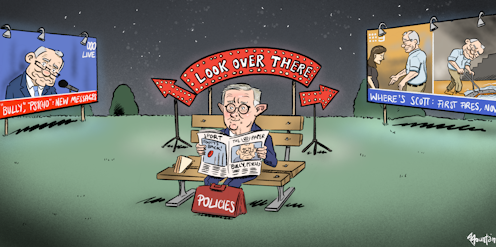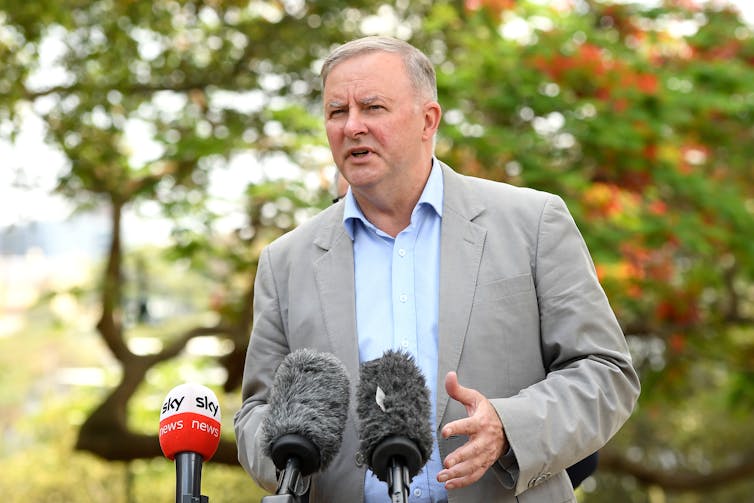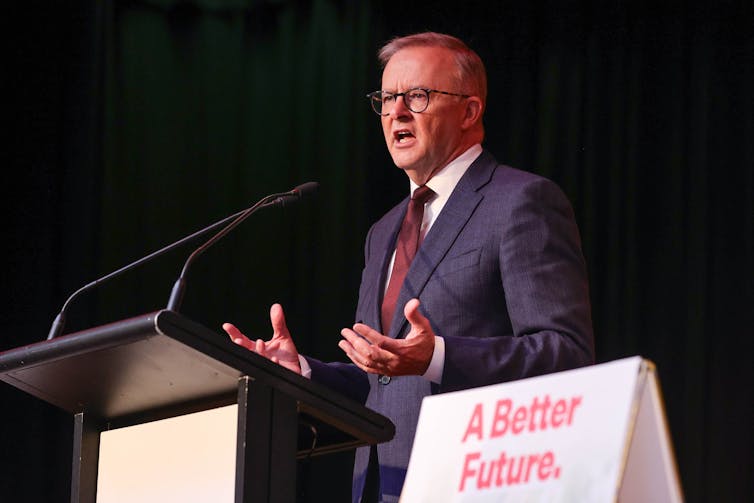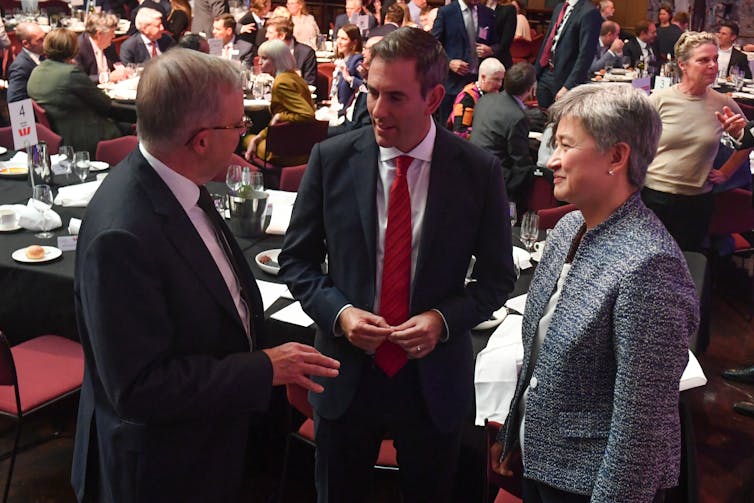Source: The Conversation (Au and NZ) – By Chris Wallace, Associate Professor, 50/50 By 2030 Foundation, Faculty of Business Government & Law, University of Canberra

Wes Mountain/The Conversation, CC BY-ND
This piece is the first in a two-part series. Its companion piece, How the Coalition can win the 2022 election, can be found here.
Every election is winnable, by either side, as the 2019 election showed. Labor enters this one in better shape, and with better prospects, than last time.
Providing it’s not bested over the tough weeks of the campaign itself, and barring shock developments before election day, Labor appears to be on track for victory. These are things it needs to do to make sure it gets there.
1. Anthony Albanese should continue to be “the reasonable person”
Compare television footage of Albanese at the beginning of his opposition leadership with now and you see a leader who has worked hard to make himself fit – and to look fit – for office.
He is not perfect, but has not made the perfect the enemy of the good. In the tradition of Bob Hawke making himself electable by forgoing the grog and giving up savaging journalists, Albanese now stands tall, dresses professionally and speaks more clearly. He has gone from looking like someone from the Annandale Hotel’s front bar to a leader one can easily see living in The Lodge.

AAP/Albert Perez
Albanese has also perfected the “reasonable person” image essential to making voters comfortable about installing him there for the next three years. By vastly improving his public presentation, running a tidy and effective opposition, and not scaring the horses, Albanese has made Labor more competitive at this election than it was in 2016 or 2019 – elections it only narrowly lost.
Crucially, his personal efforts and strategic approach, combined with extraordinary caucus loyalty, have enabled him to turn around the massive net popularity advantage Scott Morrison once enjoyed.

AAP/Russell Freeman
While Albanese’s Newspoll net approval rating of -1 is not stellar, it’s significantly better than the now toxic Morrison’s net approval rating of -12.
The more popular leader doesn’t always win federal elections. However, the last three times governments fell (at the 1996, 2007 and 2013 elections), the opposition leader had a higher net approval rating than the prime minister who lost. Albanese needs to maintain this advantage during the campaign.
Read more:
Coalition and Greens gain in post-budget Newspoll as an Ipsos poll gives Labor a large lead
2. Labor should remain disciplined to keep the focus on government bungles
Morrison overcame the political damage from his truculence during the 2020 bushfire crisis when he reluctantly returned from an Hawaiian holiday and declared he “did not hold a hose”.
Voters forgave him and his standing recovered. Since then, voters have joined the dots between this and several other areas of perceived underperformance. There was the COVID-19 vaccine “strollout”, the punitive and unlawful “robodebt” scheme, the mishandling of the Brittany Higgins rape allegation and historic rape allegations against cabinet minister Christian Porter, and slackness over the organisation of COVID-19 booster shots and RAT tests, among other bungles and integrity clouds.
French President Emmanuel Macron’s response last year “I do not think, I know” to the question of whether Morrison lied in dealings with him over a major defence contract proved a turning point.
Macron’s comment tipped the accumulated weight of the government’s poor performance into a fundamental adverse shift in voter perceptions of the Coalition. The government had not reversed this by the time the election was called.
Labor has to keep attention on the pattern of Coalition incompetence and avoid making itself the issue.
Read more:
Tax cuts? COVID management? On the search for the Morrison government’s legacy (so far)
3. Labor should resist the temptation to exploit the Liberal Party NSW division’s implosion
When you see an opponent digging a hole for themselves, don’t interfere – let them keep digging. The prime minister’s central involvement in the chronic Liberal preselection stoush in his home state of NSW has put the government’s re-election at risk. This is because survival depends on the Coalition picking up enough seats from Labor in NSW to offset expected losses in other states.
Yet Morrison has stubbornly prioritised preselection protection for his unpopular factional ally Alex Hawke over getting the NSW division of the Liberals election-ready. While the NSW court of appeal gave Morrison a victory of sorts this week when it dismissed a claim that the hand-picking of candidates was invalid, the damage within the party has been done and bitterness remains.
This kind of “precipice” politics is extraordinary so close to a poll: the printing of corflutes and campaign literature featuring candidates for a number of seats awaited the exhaustion of legal challenges to Morrison’s plan.
Providing Labor lets Liberal infighting in NSW speak for itself, there will be dividends to the opposition in a populous state with a large number of seats.
4. Labor should continue its ‘smart target’ policy approach and showcase its best frontbenchers prominently in the campaign
Learning from errors last time round, Labor can avoid becoming the subject of a large-scale fear campaign by keeping policy strategic, straight-forward and easily communicated to voters. There is no equivalent this time of Labor’s complicated 2019 franking credits policy or uncosted climate change policy, both vehicles for damaging coalition attacks.
Further, Labor has a higher performing frontbench than last time. Albanese has done a better job than his predecessor Bill Shorten in matching the best frontbench talent with the right portfolios to show Labor as an effective alternative government.
Several strong performers, such as Shadow Treasurer Jim Chalmers in the vital economic sphere and Shadow Foreign Minister Penny Wong in the sensitive foreign policy area, showcase Labor’s readiness for office.
They and talented colleagues should feature strongly in Labor’s paid advertising, letting voters know Albanese has a strong frontbench and signalling that his government, in contrast to Morrison’s, won’t be dysfunctional.

AAP/Mick Tsikas
5. Albanese should draw on voter goodwill by association with Labor’s successful state premiers
Voters strongly supported the approach of state premiers during the most dangerous phases of the COVID-19 pandemic. Most of these were Labor premiers, who benefited in opinion polls and at the ballot box for keeping citizens safe.
Queensland Labor Premier Annastacia Palaszczuk won her third election in a row. Western Australian Labor Premier Mark McGowan was re-elected with a majority so big the Coalition was reduced to just two MPs in the WA parliament’s lower house.
Liberal premiers who replicated the Labor premiers’ approach, and pushed back against Morrison’s pressure to open up early, did well. Those who went with the Morrison approach were punished: Liberal South Australian premier Steven Marshall lost office last month, and the minority government of NSW Premier Dominic Perrottet is deeply unpopular and clinging to power by a thread.
The Labor brand has benefited from the Labor premiers’ pandemic leadership. Albanese should subtly encourage perceptions he is from the same mould, being seen with them in judicious quantities, to get some spillover benefits by association.
![]()
Chris Wallace has received funding from the Australian Research Council.
– ref. How Labor can win the 2022 election – https://theconversation.com/how-labor-can-win-the-2022-election-179750








